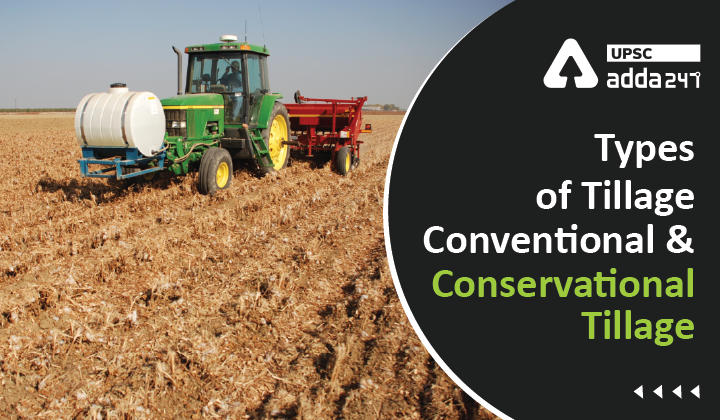Table of Contents
Soil tillage UPSC
- Soil tillage is an important practice for a good agricultural produce. It is the agricultural preparation of soil by mechanical agitation of various types, such as digging, stirring, and overturning. In the last article, we discussed about the primary tillage and the secondary tillage. In this article, we will discuss about conventional and conservational Tillage.
Conventional tillage
- Conventional tillage means soil cultivation using plough, harrow and other farm tools to prepare the field for crop production.
Conventional tillage advantages
- Destroys pests’ shelters and disrupts their lifecycles
- Exposes pests to predators and unfavourable conditions
- Distributes soil nutrients throughout the soil
- Aerates the soil
- Controls weeds
- Makes other farm cultural practices easier to undertake
Conventional tillage disadvantages
- Destroys the soil cover and its structure
- Enhances soil erosion
- High moisture loss
- Disrupts the lifecycle of beneficial soil organisms
- Needs more labor cost for the soil preparation
Conservation tillage
- Conservation tillage means planting or sowing of a crop in the previous crop’s residues that are purposely left on the soil surface.
Conservation tillage advantages
- Conserves water. The mulch reduces water to evaporate.
- Reduces erosion because the topsoil is protected.
- Reduces soil compaction.
- Protects impact from rain and wind.
- Improves the soil condition with the increased organic matter content.
- Natural enemies have places to stay.
- Lessens the overall production cost.
Conservation tillage disadvantages
- Needs a thorough understanding of the concept and requires careful farm management practices to be successful.
- Increases soil pest population.
- Weeds compete with the main crops.
- High tendency of a carryover of the insect pests and diseases from the crop residues.
- Organic matters are not evenly distributed or are concentrated at the topsoil.
Methods of conservation tillage
Zero tillage
- Zero tillage is also called as no till.
- Zero tillage is a system where the soil is not disturbed between harvesting one crop and planting the next.
- It is a crop production where the soil is not traditionally tilled or cultivated, and the use of sticks or other planting equipment are only to make the openings for seeds.
- Zero tillage is an extreme form of minimum tillage.
- Primary tillage is completely avoided and secondary tillage is restricted to seedbed preparation in the row zone only.
Ridge tillage
- Ridge till is a specific form of no-till wherein a new crop is planted on pre-formed ridges or hills or bunds from those of the previous crop.
- After harvest, the crop residues are left until the planting time.
- The seeds are sown along the ridges.
Stubble mulch Tillage
- Conventional method of tillage results in soil erosion. Stubble mulch tillage or stubble mulch farming a new approach was developed for keeping soil protected at all times whether by growing a crop or by crop residues left on the surface during fallow periods.
- It is a year-round system of managing plant residue with implements that undercut residue, loosen the soil and kill weeds.



 TSPSC Group 1 Question Paper 2024, Downl...
TSPSC Group 1 Question Paper 2024, Downl...
 TSPSC Group 1 Answer key 2024 Out, Downl...
TSPSC Group 1 Answer key 2024 Out, Downl...
 UPSC Prelims 2024 Question Paper, Downlo...
UPSC Prelims 2024 Question Paper, Downlo...




